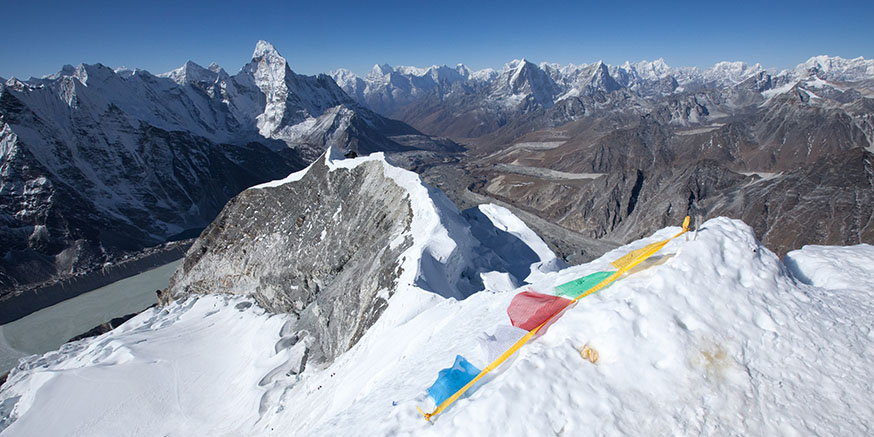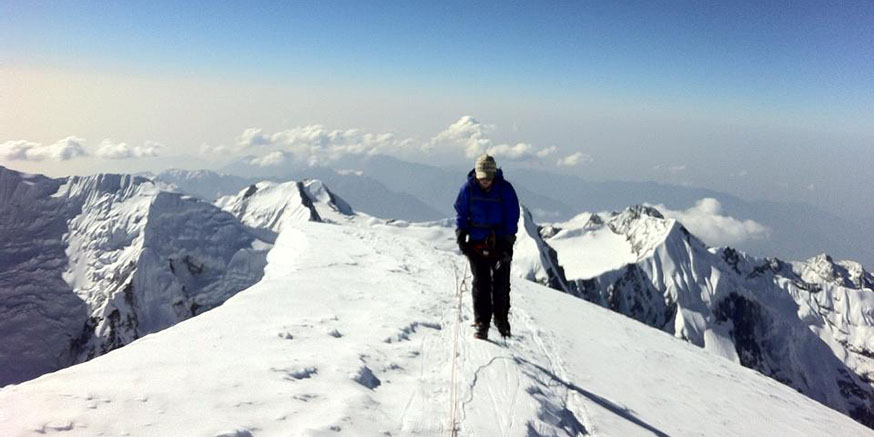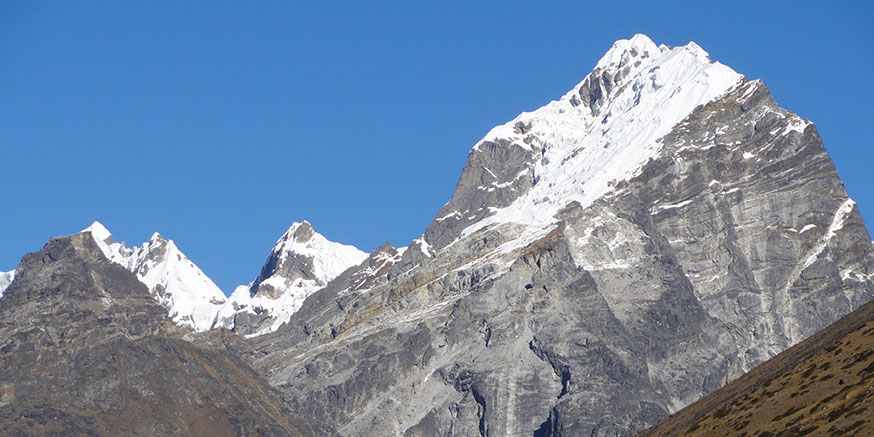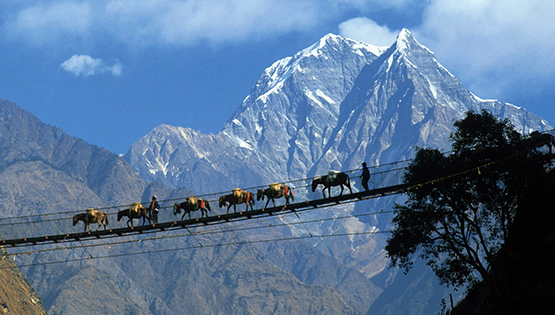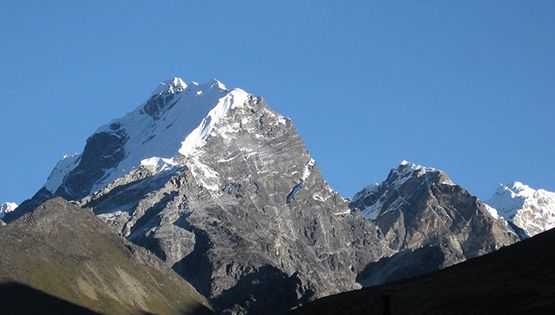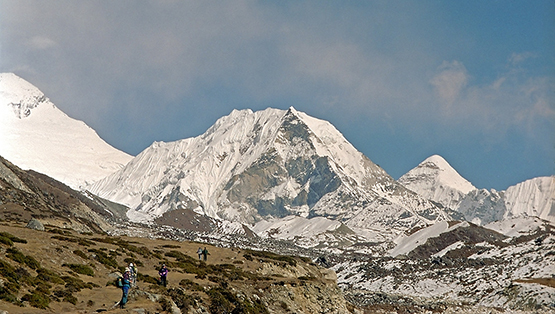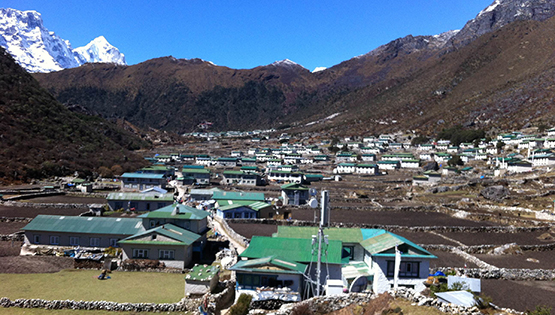Island Peak (6,189m) is one of the main climbing peaks in Everest Region with a remarkable and decidedly glaciated West Face that ascends from the Lhotse Glacier. The mountain was named "Island Peak" in 1952 AD due to its striking location in the middle of the Chhukung valley, like an Island on a sea of ice. Island peak also known as Imja Tse peak is an extension of the ridge that comes down from the south end of the Lhotse shar, situated hardly 10 kilometers away from the Mount Everest. This Island peak climbing offers an excellent opportunity to climb a Himalayan Island Summit together with an exhilarating Trek to the Everest Base Camp and Kala Pattar. The magnificent views from the summit, however, are certainly a fitting reward for your efforts. Island peak climbing is considered physically challenging, but not technically difficult.
Climbing of Island peak adventure gives you the opportunity to behold the never-seen-before locations ranging from mountains, glaciers, backpacking and famous mountain trails. The Island peak climbing offers you enough opportunity to enjoy the amazing view of Mt. Everest including several other similar peaks and explore the Buddhists monasteries and shrines along with extraordinary wildlife. Path via Gokyo RI, Chukkung RI and Kalapathar are more essence for the classic views of icefalls and glaciers of Mahalangur Himalayan range. Imja Tse/Island not only provides an enjoyable climb but also provides some of the different spectacular scenery of Himalayas in the Khumbu region including the Mt. Everest 8848m, Mt. Nuptse 7,855m, Lhotse 8,516m, Makalu (8475m) in the east, Baruntse 7720m, and Mt. Amadablam 6856m in the south adding more charm for climbing Island Peak. We pass through other villages like Khumbu, Khunde and Khumjung.
This island peak climbing expedition offers wonderful trekking through the glorious Khumbu region and any fit enthusiast is welcome to join the team. Sensational views of array of high snow capped mountains, dramatic landscapes, verdant high valleys, Buddhist culture, warm-friendly hospitality of high landlers, pristine lakes, breathtaking view points, in the heart of world's heritage 'Sagarmatha National Park' are the key features of Island Peak climbing that will be your once in a life experience.
A very warm welcome to the Kingdom of Himalayas. Upon your arrival at the Tribhuvan international airport our representative welcomes you and assists you transfer in your hotel in Kathmandu. After time to get refreshed, evening you'll meet and transfer for welcome dinner in one of the typical Nepalese restaurant in the heart of Kathmandu i.e. Utsav or Nepali Chula (Kitchen). Here you will not simply experience the traditional Nepalese dish but will be entertained with Nepalese traditional dance and folk songs. After the dinner, you will be transferred back to your respective hotel.
Kathmandu is the historical and cultural heart of Nepal and has been a popular destination for tourists ever since Nepal opened its doors to visitors. The city presents a wonderful mix of Hinduism, Tibetan Buddhism and Western influence in the Valley. Bauddhanath: Stupa with its 130 ft. dome. One of the world’s largest Stupa, Bouddha is generally acknowledged to be the most important Tibetan Buddhist monument outside Tibet. Pupshupatinath Temple: Pashupatinath is considered one of the holiest shrines of all the Hindu temples. The temple has remained the presiding deity of ruling Nepalese Royalty. -After the city tour, our leader or guide will do the final briefing of the expedition. They will also take the opportunity to check the members' personal equipment as the city bazaars and climbing shops will provide the last chance to correct any deficiencies. Overnight at Hotel.
We will make an early morning start for the sixteen-seater Twin Otter flight to Lukla (2,840m/9,317ft), the threshold to the land of legendary Sherpas and the highest mountain on earth, Mt. Everest. This is an exciting flight, which should give a glimpse of Everest in the distance (remember to sit on the left hand side of the plane!). The landing on the tiny airstrip at Lukla is, to put it mildly, exciting. In Lukla, we'll meet our trek staffs and porters, and after a short break at Lukla we'll set off for our first night's stop at Phakding (2,652 m/8,698 ft). Situated on the banks of the Dudh Kosi, which drains the whole of the Khumbu Region, this small hamlet is on the main trade route through the area and there are a number of clean, well-built lodges where we can spend the night.
We will continue up the banks of the Dudh Kosi, crossing it twice by small suspension bridges before reaching the Khumbu National Park. We will then cross the confluence of the Dudh Kosi and the Bhote Kosi on a high suspension bridge and climb steeply for about two hours up 'Namche Hill' to reach Namche Bazaar (3,445m/11,155ft). This is a prosperous trading town and the capital of the Khumbu Region. Many Tibetans cross the nearby border to trade their wares and the local market is a fascinating spectacle. This is a good place to buy genuine Tibetan artefacts. Just across the valley to the east stand the peaks of Thamserku and Kangtega, both very impressive mountains.
Namche Bazzar is the highlight of EBC trek and the heart of the Everest (Khumbu) region which has government offices, ATMs, Internet cafes, shops, restaurants, a bakery and a colourful market each Friday evening and Saturday. This is first scheduled 'acclimatization' day for this trek. Health experts always recommend us to stay active and moving during the rest day too instead of being idle. If we trek few hundred meters vertical during the day, it will help us to acclimatize with the alien heights that we are going to confront on the trek. Having been born, guiding and leading trips in the Himalayas, we believe in the natural process of acclimatization, "Climb high, sleep low". We take an interesting side trip up to Khumjung and climb up to famous airstrip at Syangboche. Just above the airstrip is the Everest View Hotel (3800m), a Japanese scheme to build a deluxe hotel with great views of the highest mountains on Earth. The Khumjung valley surrounded by the snowy peaks of Kongde and Thamserku, and the sacred peak the Khumbiyul-lha hosts a well known monastery that houses a yeti scalp. Visit Hillary School which is at the same site and spending some time in Khumjung after having lunch there, we walk back down to Namche Bazaar. Overnight in Namche Bazaar.
After breakfast in Namche, we start our trek towards Tengboche enjoying superb view of Mt. Everest, Nuptse, Lhotse, Ama Dablam and close up view of Thamserku. Our trek follows on the gradual trail with few ups and downs overlooking magnificent view of the great Himalaya. Along the way we can spot wild lives like Impeyan pheasant, musk deer, or a herd of Himalayan Thar. The trail goes gradually down up to Kyangjuma. The path eventually reaches Sangnasa which is the major trail junction to Gokyo valley and Everest Base Camp. The track then follows through the pine forests and after we cross the prayer flags festooned bridge over Dudh Koshi River, we reach Phungi Thenga, a small settlement with a couple of teahouses and a small army post amidst the alpine woods. After having a relaxed lunch at Phungi Thenga we then have a little tough climb steep up through the pine forests while before we reach Tengboche. Tengboche, a home of an impressive and recently rebuilt monastery is a great place for close up views of Ama-Dablam, Nuptse, and Everest. We have plenty of time to look around Tyangboche and have a cake at the bakery before dropping down to the village of Deboche (3,700m/12,135ft), where we will stay in a relaxing lodge.
It is 1.5 hours walk further up the trail to the village of Pangboche (4,000m/13,120ft). Pangboche is situated right at the foot of Mt. Ama Dablam and many of the Sherpas who are engaged in mountaineering and trekking industry each season are from this village. Mt. Amadabla is the famous Matterhorn of the Himalaya. From Pangboche we continue up the trail to Pheriche, where we'll stay in one of the finest lodge.
It is very important to spend an additional night here to aid to the acclimatization process. It can be along a short hike of 400 meters climb to the Nangkartshang Gompa (Monastary) on the ridge, to the north of Dingboche village. From here we can catch a good view of Mt. Makalu (8463m) and the great views up the Khumbu and Imja Valleys. In the afternoon, there is time for an altitude briefing by the Himalayan Rescue Association in Pheriche.
The first part of the day is relatively easy, and lovely stroll along the flat river valley to reach the foot of the Khumbu Glacier. We stop for the lunch or tea at Duglha lodge before tackling the steep ascent up the rocky slopes of the glacier. The steep climb of around an hour and half from Duglha, we'll come across the highest memorandum graveyard of those who have died on Mt. Everest. The square blocks of rock like cairn or CHORTEN are the memorials of Everest climbers. These memorials are not only a special place to explore, but it also marked the end of the steep climb. All that is left is to traverse across the side of the glacier to the lodges at Lobuche. Stark and rugged beauty creates almost moonscape campsite at Lobuche, and a windswept collection of huts tucked in a narrow meadow among the glacier, Mt. Lobuche, Mt. Tawoche, and Mt. Nuptse, looks particularly spectacular.
The first section of the trail from Lobuche follows the narrow gap between the glacial moraine and the mountain walls, past turn off to the Italian pyramid. Take time to detour to the edge of moraine to look over the Khumbu glacier. Along windy and rocky path with the wonderful view of Mt. Pumori, Nuptse and other magnificent peaks, we reach Gorakshep. Gorakshep is the location of the original Everest Base Camp with the new camp being further up the valley. After lunch our adventure continues towards Everest Base Camp. The trail passes through over rocky dunes and moraine and streams. The Base Camp area provides an opportunity to experience the freezing and harsh conditions that mountaineers brave to summit this famous mountain. In Everest Base Camp the climbers gather for summiting Everest during the high expedition season. We explore base camp and its surroundings glacier and return back to Gorakshep.
Mornings are usually sparkling and clear and this is the best time to climb the Kalapathar for one of the world's definitive mountain views. We will be rewarded the 360 degree dramatic panorama views of Mt Everest and surroundings mountains like Mt. Pumori, Mt. Lingtren, Mt. Khumbetse, Mt. Nuptse, Mt. Lhotse, Mt. Ama Dablam, Mt. Thamserku along with many other peaks. You will have an easy walk for about 2hrs to reach Lobuche. Stark and rugged beauty creates almost moonscape campsite at Lobuche a windswept collection of huts tucked in a narrow meadow between the glacier and the Lobuche peak. Tawoche and Nuptse are particularly spectacularly from Lobuche towering.
From Lobuche we'll trek down to a thickly populated village known as Dingboche, which is the highest place in Asia after Tibet to grow Barley. After 2 hours of easy descend to Dingboche, it’s a gentle uphill climb of around 2 hours to reach the today’s destination, Chhukung.
Today is another short trek of four hours to the Island Peak base camp (about 5450 m). Beginning today, accommodations will be tented camps for the next two days, with food prepared by our professional chef. Overnight at tented camp.
Today, after breakfast we packed all our camping gears and climb towards the high camp which is around 2 to 3 hours of walking. The trail goes steeply up and turn left to the hillside. After reaching at the top of the hillside, we go through steep rock way to reach our camp for the overnight. Overnight at tented camp.
Like every expedition, today is the most important and adventurous day of the trip. Depending on the weather, we’ll start our climb early in the morning through the several short rock steps to emerge on the right side of the rock gully. We then follow the ridgeline, leading to an exhilarating and exposed traverse onto the snout of the summit glacier. From here we go through several crevasses as we need to rope-up. We then follow the snow and ice slope where guide and sherpas will fix the rope, which lead us to the top of the peak. The view of the entire chhukung valley, the rapidly growing Imja lake, the north face of Mt. Amadablam, and the gigantic Mt. Makalu (8,481 m) can be viewed from the summit, which is simply astounding. After taking dozens and dozens of photographs from the summit, we then descend all the way down to Chhukung village for the overnight stay at guest house.
Today we follow the same route back down to Tengboche (3860m). Passing through Dingboche, Pangboche and Diwoche, the day’s trek will take six hours. We can visit the monastery the same day at around 3 p.m. to witness the ceremony in the principal and popular monastery of Everest region.
Leaving the mountains behind, our descent takes us from Tengboche Monastery to a riverside hemlet named, Phungi Thanga. Crossing on the newly built suspension bridge at Phungi Thanga; we climb up the opposite side of the valley to reach the contouring path leading back through Namche Bazaar. We should have enough time in Namche to shop and relax in the bakery with a coffee and a cake, or even to check the Internet. A steep descent for 600m/2,000ft down Namche Hill leads to the suspension bridge crossing the Dudh Kosi river and the small village of Monjo (2,835m/9,300ft). Not only is Monjo a quieter place to stay than Namche, it also means our porters have a less strenuous walk back to Lukla tomorrow.
The trail now flattens out and we cross the river twice more before a rising traverse up the hill-side, past numerous tea-houses to Lukla. Our last day of steady trekking will be a real joy as at lower altitudes, with two weeks behind us, and nothing left to prove, we can soak up the atmosphere in each of the villages we amble through. All excess energy is guaranteed at our party this evening with our Nepalese crew.
Saying final goodbye to our porters, we fly back to Kathmandu after our long mountain journey. The flight time to Kathmandu are scheduled in the morning normally because Lukla suffers a lot of wind afternoon. Sometime the flight time can be delayed due to bad weather and other reasons. The early morning flight drops us at Kathmandu and the Getaway Himalaya van or coach will transfer you to the hotel. You may have time to relax after long journey and take back your breath and rest at your hotel with ending your Himalayan expedition. Remember, we will be hosting a fantastic celebration dinner together in the finest restaurant in Thamel, in occasion of successfully completing your Island peak climbing!
Rest and relax at the hotel after such a wonderful trip. The day is also reserved as a contingency day due to flight delays or other unforeseen conditions. For those eager to see as much of Kathmandu as possible, an early start is worthwhile to visit the temples of Pashupatinath and Swayambhunath and districts of Bhaktapur and Patan. Durbar Square is also on the essential list, as is the shopping area of Thamel. In the evening you can have your last night in Nepal, enjoying the Nepali cultural dinner show or go out to Thamel.
Today is free or last minute shopping for souvenirs or gift to your family, friends or relatives for you until your departure flight/drive or to commence any extra trips or activities you may have booked with us. If departing, you'll be transferred to the International Airport for your departure flight to your onwards destination.
- 4 night hotel accommodation in Kathmandu in a 4 star category hotel. Breakfast is included. Accommodation is on a twin share basis. Single rooms are usually available at an additional cost. Please inform us as early as possible if you wish to have a single room.
- One day guided city sightseeing tour in & around Kathmandu (largest Buddhist stupa in the world at Bouddha Nath and most important Hindu temple in the valley at Pasupati Nath and famous Monkey temple Swyambhunath). Either before or after the trek with fully licensed tour guide and transportation. Other city tour will be arranged by us on request for additional cost if you wish and have spare day.
- All Entrance ticket fees for all tourist sites listed in our itinerary.
- Mt. Island/Imja Tse Peak climbing permit/Sagarmatha National park entry fees,Khumbu Pasang Lhamu Rural Municipality Entrance Fee & all government taxes.
- Return Domestic flight ticket KTM-LUKLA-KTM (In a Fixed wing Twin Otter) all guests, a Guide & local staff.
- All pickup and drop transportation from airport to airport both domestic & international airports. All guests are kindly requested to try and arrange your international travel flight to arrive at Tribhuvan International Airport (TIA) in Kathmandu at same time (if possible), helping us to avoid multiple journeys to airport during the peak season.
- Domestic airport taxes.
- One locally made water Proof Duffel bag with your Name & Grand Himalaya’s Logo on it will be provided by us for the Trek, it is yours so you may take it back to home with you or return to us at the end of trip if you wish.
- All meals during the trek period, 3 times a day Breakfast/Lunch/Dinner/all hot drinks/2liters of proper boiled water per guest per day for drinking. Meal can be selected from the teahouse menu according to individual choice.
- An experienced Local Sherpa guide who knows the area, mountain, local people & culture very well.
- Assistant Sherpa (4 climbers = 1 assistant guide).
- Appropriate number of porters, 1 porter between two guests.
- Farewell dinner in Kathmandu after the trek, local cultural music and Dance show in a well reputed restaurants, Bhojan Griha/Nepali Chula/Utsav with guide/staff (TBC)
- Insurance coverage of accidental death, Medical expenses & emergency Helicopter evacuation for all local staff.
- All porters properly insured & equipped.
- 1 Bottle of “SUMMIT†Oxygen with set of mask and regulator will be provided during the trek, (Just for emergency medical use only).
- A comprehensive medical kit. All guests are requested to bring your own personal First Aid Kit with sufficient medication supplies for trip.
- One regular/simple cell phone with local SIM Card & charger cable will be provided in the team during the trip. Guest will be requested to return this to Grand Himalaya staff at the end of the trip.
- Travel and rescue arrangements.
- International & home country domestic airfares, transfers en route & excess baggage.
- Your personal insurance: Medical, mountain rescue cover and repatriation is obligatory.
- Your personal expenses e. g phone calls, laundry, alcoholic beverage, mineral/bottled water, charges of showers, cost of electronic devices charging facilities and wireless internet (Wi-Fi) fees in the tea house.
- Main meals (Lunch & Dinner) in Kathmandu apart from celebration meal (Allow up to USD12-15 per meal).
- Your Nepal entry visa fee (USD $40 available on entry) Valid for 30 days.
- Tipping in Nepal & Tibet is customary. (Allow USD: 150-200/Per guest)
- Excess baggage above 15 kg will be extra charged USD: 1.5 per kg during the peak season.
- Extra night accommodation in Kathmandu because of early arrival, late departure, early return from mountain (due to any reason) than the scheduled itinerary.
- Personal Climbing/Trekking Gear for the trip.
Note: Please be advised, an extra cost of USD500-800/-per guest will be applicable for chartering a private Helicopter in the event of bad weather disturbance on the fixed wing twin Otter flight IN/OUT of Lukla.
- More than 42 days before departure 30% of total cost
- 42 to 29 days 50% of total cost
- 28 days to 15 days 75% of total cost and
- 14 days or less 100% of total cost.
